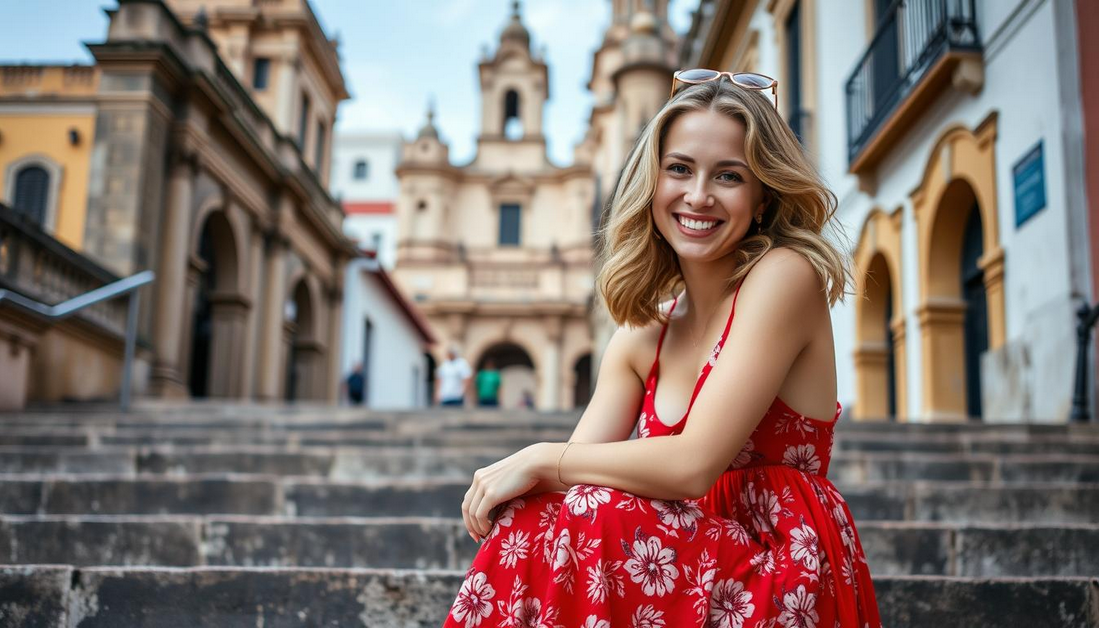India customers to view on amazon.in
Cartagena’s Walled City: Colors, Culture, and Charm
Welcome to Cartagena’s Walled City, a vibrant destination where colors, culture, and charm blend together to create an unforgettable experience.
- The Colorful History of Cartagena’s Walled City
- From Pirates to Preservation: The Story Behind the Walls
- UNESCO World Heritage Status and Its Significance
- Exploring Cartagena’s Walled City: Colors, Culture, and Charm
- The Vibrant Color Palette of Colonial Architecture
- Cultural Significance of the Historic Center
- The Undeniable Charm of Cobblestone Streets
- Must-Visit Landmarks Within the Walled City
- The Iconic Clock Tower (Torre del Reloj)
- Plaza de los Coches and Its Colonial Charm
- Plaza Santo Domingo and the Botero Sculpture
- Palacio de la Inquisición: A Dark Chapter in History
- Beyond the Walls: Castillo de San Felipe de Barajas
- The Vibrant Getsemaní Neighborhood: Where Locals Meet Travelers
- Street Art and Cultural Expression
- Plaza de la Trinidad: The Heart of Getsemaní
- Authentic Local Experiences
- Cultural Immersion: Music, Dance, and Traditions
- Cumbia and Champeta: The Rhythms of Cartagena
- Traditional Palenqueras and Their Colorful Fruit Baskets
- Local Festivals and Celebrations
- Culinary Journey Through Cartagena
- Traditional Colombian Dishes to Try
- Best Restaurants in the Walled City
- Street Food Adventures
- Nightlife and Rooftop Bars
- Day Trips and Nearby Attractions
- Convento de la Popa: Hilltop Monastery with Spectacular Views
- Playa Blanca on Barú Island: Caribbean Paradise
- The Rosario Islands: Crystal Clear Waters and Coral Reefs
- Practical Travel Tips for Visiting Cartagena
- Best Time to Visit: Weather and Festivals
- Getting Around the Walled City
- Where to Stay: From Boutique Hotels to Historic Mansions
- Safety Tips for Travelers
- Conclusion: The Timeless Appeal of Cartagena’s Walled City
- FAQ
- What is the best time to visit Cartagena’s Walled City?
- How do I get around Cartagena’s Walled City?
- What are the must-visit landmarks in Cartagena’s Walled City?
- What is the significance of the Castillo de San Felipe de Barajas?
- What can I expect to experience in the Getsemaní neighborhood?
- What are some traditional Colombian dishes I should try in Cartagena?
- Are there any day trips or nearby attractions I can visit from Cartagena?
- What safety precautions should I take when visiting Cartagena?
- Where can I stay in Cartagena?

This historic center, surrounded by impressive walls, is a treasure trove of Colombian history and architecture. As you step inside, you’ll be greeted by the warm smiles of locals and the sight of colorful buildings.
Colonial Cartagena is a must-visit destination for anyone interested in history, culture, and vibrant city life. In this article, we’ll explore the colors, culture, and charm that make Cartagena’s Walled City so special.
Key Takeaways
- Discover the rich history and architecture of Cartagena’s Walled City.
- Explore the vibrant colors and cultural experiences that await you.
- Learn about the charm that makes this destination a must-visit.
- Find out why Cartagena Colombia is a top travel destination.
- Get insights into the colonial heritage of Cartagena.
The Colorful History of Cartagena’s Walled City
Cartagena’s Walled City is a testament to the city’s rich and vibrant history. Founded in 1533 by the Spanish, Cartagena quickly became a strategic location for trade and commerce, attracting the attention of pirates and privateers.
“The city’s early years were marked by numerous pirate attacks, with the most notable being the sack by the French pirate Jacques de Sores in 1544,” a event that would shape the city’s defensive structures for centuries to come.
From Pirates to Preservation: The Story Behind the Walls
The construction of the walls and fortifications around Cartagena’s Old Town began as a response to these pirate threats. The Spanish built an extensive system of walls, bastions, and forts, including the famous Castillo de San Felipe de Barajas. These structures played a crucial role in defending the city against numerous attacks, showcasing the resilience and determination of its inhabitants.

UNESCO World Heritage Status and Its Significance
In 1984, Cartagena’s Walled City was designated a UNESCO World Heritage Site, recognizing its cultural and historical significance. This prestigious status has helped preserve the city’s architecture and traditions, ensuring that its charm is maintained for future generations. The preservation efforts have been instrumental in protecting the city’s unique heritage, making it a must-visit destination in Colombia.
The blend of Spanish colonial architecture, vibrant cultural scene, and historical significance makes Cartagena’s Walled City a truly unique destination, embodying the essence of Cartagena Colombia attractions.
Exploring Cartagena’s Walled City: Colors, Culture, and Charm
As you step into Cartagena’s Walled City, you’re immediately enveloped in a world of vibrant colors and rich cultural heritage. The city’s historic center is a living, breathing entity that pulsates with energy and tradition.

The Vibrant Color Palette of Colonial Architecture
The colonial architecture in Cartagena’s Walled City is a feast for the eyes, with buildings painted in a kaleidoscope of colors. The vibrant facades and balconies seem to dance in the streets, creating a lively atmosphere that’s impossible to resist.
The use of bright colors is not just aesthetically pleasing; it’s also a reflection of the city’s cultural heritage. The colonial architecture is a blend of Spanish, African, and indigenous influences, making it a unique and fascinating aspect of Cartagena’s identity.
| Color | Significance |
|---|---|
| Blue | Represents the Caribbean Sea and the city’s maritime history |
| Yellow | Symbolizes the sun and the city’s warm climate |
| Red | Signifies the passion and energy of the city’s inhabitants |
Cultural Significance of the Historic Center
The historic center of Cartagena’s Walled City is not just a collection of old buildings; it’s a living, breathing entity that pulsates with culture and tradition. From the Plaza de los Coches to the Clock Tower, every landmark is steeped in history and significance.
“Cartagena’s Walled City is a testament to the city’s rich cultural heritage, with its vibrant colors, colonial architecture, and historic landmarks.” –
Travel Writer
The Undeniable Charm of Cobblestone Streets
As you wander through the cobblestone streets of Cartagena’s Walled City, you’ll discover the undeniable charm of this ancient city. The quaint shops, restaurants, and cafes are a perfect blend of traditional and modern, making it a delightful experience for visitors.
The cobblestone streets are not just a relic of the past; they’re a living, breathing part of the city’s identity. They add to the city’s charm, making it a must-visit destination for anyone looking to experience the authentic Cartagena.
Must-Visit Landmarks Within the Walled City
Cartagena’s Walled City is a living museum, with landmarks that tell the story of its vibrant past. As you explore this historic area, you’ll discover a variety of iconic sites that are steeped in history and culture.
The Iconic Clock Tower (Torre del Reloj)
The Torre del Reloj, or Clock Tower, is one of Cartagena’s most recognizable landmarks. This 17th-century tower marks the entrance to the walled city and is a must-visit attraction. Its stunning architecture and picturesque surroundings make it a perfect spot for photos.

Plaza de los Coches and Its Colonial Charm
Plaza de los Coches is a vibrant square that embodies the colonial charm of Cartagena. Surrounded by historic buildings, cafes, and shops, this plaza is the perfect place to soak up the local culture and enjoy the lively atmosphere.
Plaza Santo Domingo and the Botero Sculpture
Plaza Santo Domingo is another significant landmark within the walled city, known for its beautiful colonial architecture and the presence of a sculpture by Fernando Botero. This plaza is a cultural hub, offering a glimpse into the city’s rich heritage.
Palacio de la Inquisición: A Dark Chapter in History
The Palacio de la Inquisición is a sobering reminder of Cartagena’s dark past, associated with the Spanish Inquisition. This historic building now serves as a museum, providing insight into the city’s complex history and the significance of this period.
| Landmark | Description | Significance |
|---|---|---|
| Torre del Reloj | 17th-century clock tower | Iconic entrance to the walled city |
| Plaza de los Coches | Vibrant colonial square | Embodiment of Cartagena’s colonial charm |
| Plaza Santo Domingo | Colonial plaza with Botero sculpture | Cultural significance and heritage |
| Palacio de la Inquisición | Museum showcasing the Spanish Inquisition | Reminder of Cartagena’s complex past |
Beyond the Walls: Castillo de San Felipe de Barajas
The Castillo de San Felipe de Barajas stands as a monumental reminder of Cartagena’s colonial past and its struggle against pirate invasions. This 17th-century fort is an engineering marvel that has withstood the test of time, offering insights into the city’s military history.

The Engineering Marvel of the Fort
The fort’s design and construction are testaments to the advanced engineering skills of its time. Built to protect Cartagena from pirate attacks, Castillo de San Felipe de Barajas features a complex network of tunnels, bastions, and watchtowers. Its strategic location on a hilltop allowed for panoramic views of the surrounding area, making it an ideal vantage point for surveillance.
| Feature | Description |
|---|---|
| Tunnels | Complex network for shelter and movement |
| Bastions | Fortified structures for defense |
| Watchtowers | Elevated posts for surveillance |
Panoramic Views and Photo Opportunities
One of the main attractions of Castillo de San Felipe de Barajas is its panoramic views of Cartagena and the Caribbean Sea. Visitors can enjoy breathtaking vistas, making it a photographer’s paradise. The fort’s hilltop location provides a unique perspective on the city, highlighting its historical and architectural beauty.
Whether you’re a history enthusiast, an architecture buff, or simply looking for a great spot to capture memorable photos, Castillo de San Felipe de Barajas is a must-visit Cartagena attraction. Its combination of historical significance, architectural marvel, and natural beauty makes it an unforgettable experience.
The Vibrant Getsemaní Neighborhood: Where Locals Meet Travelers
Nestled just beyond Cartagena’s historic walls, the Getsemaní neighborhood pulsates with a vibrant energy that’s irresistible to both locals and travelers. This eclectic area is a haven for those seeking an authentic experience of Cartagena’s culture, far from the typical tourist trails.

Street Art and Cultural Expression
Getsemaní is renowned for its vibrant street art scene, where colorful murals and graffiti adorn the walls, reflecting the neighborhood’s cultural expression and creativity. The streets become an open-air gallery, showcasing works by local and international artists. This artistic vibe is not just aesthetically pleasing; it’s a manifestation of the community’s spirit and identity.
“Art is the only way to run away without leaving home.” This quote resonates deeply within Getsemaní, where art is not just a form of expression but a way of life.
Plaza de la Trinidad: The Heart of Getsemaní
At the heart of Getsemaní lies the Plaza de la Trinidad, a lively square that serves as the neighborhood’s social hub. Surrounded by cafes, restaurants, and bars, this plaza is where locals and travelers gather to share stories, enjoy live music, and soak up the atmosphere. It’s a place where the past and present converge, with historic buildings standing alongside modern establishments.
| Aspect | Description |
|---|---|
| Street Art | Vibrant murals and graffiti showcasing local and international art |
| Plaza de la Trinidad | Lively square with cafes, restaurants, and live music |
| Local Experiences | Authentic cultural immersion through food, dance, and community events |
Authentic Local Experiences
Getsemaní offers a plethora of authentic local experiences that allow visitors to delve into Cartagena’s culture. From savoring traditional cuisine at local eateries to participating in community events and dance classes, there’s always something to explore. The neighborhood’s warm hospitality makes it easy for travelers to connect with locals, creating memorable experiences.
Whether you’re looking to immerse yourself in Cartagena’s rich cultural heritage or simply enjoy the neighborhood’s laid-back atmosphere, Getsemaní is a must-visit destination. Its unique blend of tradition, creativity, and community spirit makes it a truly special place within Cartagena.
Cultural Immersion: Music, Dance, and Traditions
Immerse yourself in Cartagena’s culture, where music and dance are an integral part of everyday life. The city’s rich cultural heritage is palpable in its vibrant rhythms, colorful traditions, and lively celebrations.

Cumbia and Champeta: The Rhythms of Cartagena
The sounds of cumbia and champeta fill the air in Cartagena, reflecting the city’s African and indigenous influences. Cumbia, with its slow and sensual rhythm, is a staple of Colombian music, while champeta, with its faster pace and percussive beats, adds a modern twist to traditional sounds. Visitors can experience these rhythms firsthand at local dance clubs or during cultural events.
Traditional Palenqueras and Their Colorful Fruit Baskets
The palenqueras, women from the town of Palenque, are a common sight in Cartagena’s markets and streets. They are known for their colorful fruit baskets and traditional clothing, which reflect their cultural heritage. The palenqueras are not only vendors but also guardians of their community’s traditions, passing down stories and customs through generations.
Local Festivals and Celebrations
Cartagena hosts numerous local festivals throughout the year, showcasing its Colombian traditions and Cartagena culture. The city’s calendar is filled with events that celebrate its history, music, and dance, offering visitors a chance to experience the city’s vibrant cultural scene. From religious processions to music festivals, there’s always something happening in Cartagena.
Culinary Journey Through Cartagena
The flavors of Cartagena are as diverse as its history, blending indigenous, Spanish, and African influences. This rich cultural heritage is reflected in the city’s cuisine, making it a paradise for food lovers. From traditional Colombian dishes to fresh seafood, Cartagena’s culinary scene is a vibrant reflection of its coastal location and cultural traditions.

Traditional Colombian Dishes to Try
When exploring Cartagena’s culinary delights, there are several traditional Colombian dishes you shouldn’t miss. Sancocho, a hearty stew made with fish or meat, and various vegetables, is a staple. Arepas, cornmeal patties often served with cheese or meat, are another favorite. For a truly local experience, try Empanadas, pastry pockets filled with meat, cheese, or vegetables, and Patacones, fried green plantains that are flattened and then fried again until crispy.
Best Restaurants in the Walled City
Cartagena’s Walled City is home to numerous restaurants offering a range of dining experiences. For a taste of local cuisine with a modern twist, visit La Cevicheria, known for its innovative seafood dishes. El Olivo is another popular spot, serving traditional Colombian cuisine in a beautifully restored colonial mansion. For a more casual meal, La Tasca de Durán offers delicious tapas and a cozy atmosphere.
| Restaurant | Cuisine | Price Range |
|---|---|---|
| La Cevicheria | Seafood | $$$-$$$$ |
| El Olivo | Colombian | $$-$$$ |
| La Tasca de Durán | Tapas | $-$$ |
Street Food Adventures
For a truly authentic culinary experience, explore Cartagena’s street food scene. Vendors selling fresh fruit, grilled corn, and Arepas de Huevo (egg arepas) are common. Be sure to try some Frutas Frescas, fresh fruit juices that are both refreshing and delicious.
Nightlife and Rooftop Bars
As the sun sets, Cartagena’s nightlife comes alive. Rooftop bars like La Azotea at Hotel La Passion offer stunning views of the city and the Caribbean Sea. Enjoy a cocktail while taking in the breathtaking views, or dance the night away at one of the many clubs and bars in the Getsemaní neighborhood.
Day Trips and Nearby Attractions
While Cartagena’s Walled City is a treasure trove of history and culture, the surrounding areas offer a wealth of exciting day trips and attractions. Visitors can explore nearby islands, monasteries, and beaches, each offering a unique experience.
Convento de la Popa: Hilltop Monastery with Spectacular Views
Perched atop a hill, Convento de la Popa is a historic monastery that offers breathtaking views of Cartagena and the Caribbean Sea. Visitors can explore the convent’s chapel, climb to the top for panoramic views, and enjoy the surrounding gardens. The convent’s history dates back to the 17th century, and it has played a significant role in the region’s religious heritage.

Playa Blanca on Barú Island: Caribbean Paradise
Playa Blanca on Barú Island is a stunning beach destination, boasting crystal-clear waters and powdery white sand. Visitors can relax on the beach, snorkel, or take a boat tour to explore the surrounding waters. The beach is lined with local restaurants and vendors, offering a range of dining options.
The Rosario Islands: Crystal Clear Waters and Coral Reefs
The Rosario Islands are a popular day trip destination, known for their coral reefs and diverse marine life. Visitors can snorkel or scuba dive to explore the underwater world, or simply relax on the islands’ beautiful beaches. The islands offer a range of activities, including boat tours and fishing excursions.
In conclusion, Cartagena’s surrounding areas offer a diverse range of day trips and attractions, from historic monasteries to beautiful beaches and islands. Whether you’re interested in history, culture, or simply relaxing in a beautiful setting, there’s something for everyone.
Practical Travel Tips for Visiting Cartagena
With its rich history, vibrant culture, and stunning architecture, Cartagena is a must-visit destination, and these practical tips will enhance your experience. To ensure a smooth and enjoyable trip, it’s essential to be prepared.
Best Time to Visit: Weather and Festivals
The best time to visit Cartagena is during the dry season, from December to April, when the weather is warm and sunny. The city hosts numerous festivals throughout the year, including the Cartagena International Film Festival and the Cartagena Independence Day celebrations, which are worth experiencing.
Getting Around the Walled City
Getting around the Walled City is relatively easy, with many areas pedestrianized and accessible on foot. You can also use taxis or ride-sharing services to get around.
Where to Stay: From Boutique Hotels to Historic Mansions
Cartagena offers a range of accommodations to suit different tastes and budgets, from boutique hotels to historic mansions. Consider staying within the Walled City for easy access to main attractions.
Safety Tips for Travelers
As with any travel destination, it’s always a good idea to take some basic safety precautions to ensure a smooth and enjoyable trip. Be mindful of your belongings, especially in crowded areas, and avoid carrying large amounts of cash.
Some key takeaways for your Cartagena trip include:
- Plan your visit during the dry season for the best weather.
- Explore the Walled City on foot to discover its hidden gems.
- Choose accommodations that suit your style and budget.
- Stay safe by being aware of your surroundings.
Conclusion: The Timeless Appeal of Cartagena’s Walled City
Cartagena’s Walled City is a captivating destination that embodies the essence of Colombian heritage and cultural significance. With its rich history, vibrant culture, and stunning architecture, this city has a timeless appeal that draws visitors from around the world.
As we’ve explored, the city’s colorful colonial buildings, lively music, and dance scene make it an enchanting destination. Whether you’re a history buff, a culture vulture, or simply a traveler looking for a new adventure, Cartagena’s Walled City is a must-visit destination that will leave you inspired.
Traveling to Colombia to experience the magic of Cartagena’s Walled City is an unforgettable experience. With its unique blend of history, culture, and natural beauty, this city is sure to captivate your senses and leave a lasting impression.
FAQ
What is the best time to visit Cartagena’s Walled City?
The best time to visit Cartagena’s Walled City is during the dry season, from December to April, when the weather is warm and sunny.
How do I get around Cartagena’s Walled City?
The Walled City is relatively easy to navigate on foot, with many areas pedestrianized. You can also take a taxi or ride-sharing service, or rent a bike to get around.
What are the must-visit landmarks in Cartagena’s Walled City?
Some of the top landmarks include the Clock Tower (Torre del Reloj), Plaza de los Coches, Plaza Santo Domingo, and the Palacio de la Inquisición.
What is the significance of the Castillo de San Felipe de Barajas?
The Castillo de San Felipe de Barajas is a 17th-century fort that was built to protect the city from pirate attacks. It offers panoramic views of the city and the Caribbean Sea.
What can I expect to experience in the Getsemaní neighborhood?
Getsemaní is a vibrant and eclectic area that’s home to a thriving arts scene, with colorful murals and street art, lively cafes and restaurants, and a lively atmosphere.
What are some traditional Colombian dishes I should try in Cartagena?
Some must-try dishes include sancocho, arepas, and fresh seafood, as well as local fruits and juices.
Are there any day trips or nearby attractions I can visit from Cartagena?
Yes, some popular day trips include visiting the Convento de la Popa, Playa Blanca on Barú Island, and the Rosario Islands.
What safety precautions should I take when visiting Cartagena?
As with any travel destination, it’s always a good idea to take some basic safety precautions, such as being aware of your surroundings, keeping valuables secure, and avoiding traveling alone at night.
Where can I stay in Cartagena?
Cartagena offers a range of accommodations, from boutique hotels to historic mansions, many of which are located within the Walled City.








